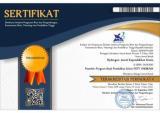The Modification of Eco-Enzyme Liquid and The Effect on Tomato Preservation with Soaking Then Rinsing in Water Method
DOI:
https://doi.org/10.33394/hjkk.v12i1.10593Keywords:
coconut, eco-enzyme, preservation, rice, tomatoesAbstract
References
Ahmad, M., Mohammed , A, M., Sale, S. (2020). Enhancing the shelf life of tomato fruits using plant material during storage. J. Hortic. Postharvest Res, 3(2), 347–354. https://doi.org/10.22077/jhpr.2020.2946.1109.
Andriani,S. E., Hintono, A. (2018). Perubahan Fisik Tomat Selama Penyimpanan Pada Suhu Ruang Akibat Pelapisan Dengan Agar-Agar Physical Changes of Tomatoes During Storage At Room Temperature Due To Coating With Agar. In Jurnal Teknologi Pangan (Vol. 2, Issue 2). www.ejournal-s1.undip.ac.id/index.php/tekpangan.
Angelia, I.O. (2022). Mempertahankan Mutu Kandungan Vitamin C Dan Umur Simpan Pada Tomat (Solanum Lycopersicum ) Dengan Pelapisan Lilin Lebah. JVST 1(2), 58-61
Apai, W. (2010). Effects of Fruit Dipping in Hydrochloric Acid Then Rinsing in Water on Fruit Decay and Browning of Longan Fruit. Crop protection, 29: 1184-1189.
Ata, H., Papuangan, N., Bahtiar. (2016). identifikasi cendawan patogen pada tanaman tomat (Solanum lycopersicum L). jurnal bioedukasi, 4(2).
Boonkorn, P. (2016). Impact of Hot Water Soaking on Antioxidant Enzyme Activities and Some Qualities of Storage Tomato fruits. International Food Research Journal, 23(3); 934-938.
Bukhari, S. A., Salman, M., Numan, M., Javed, M. R., Zubair, M., Mustafa, G. (2020). Characterization of antifungal metabolites produced by Lactobacillus plantarum and Lactobacillus coryniformis isolated from rice rinsed water. Molecular Biology Reports, 47(3): 1871–1881. https://doi.org/10.1007/s11033-020-05281-1
Dandago, M.A., Gungula, D., Nahunnaro, H. (2017). Effect of Postharvest Dips on Quality and Storability of Tomato Fruits (Lycopersicon esculentum Mill) in Kura, Kano State, Nigeria. Annals. Food Science and Technology, 18(1): 78-84.
Farooq, A., Niaz, B., Saeed, F., Afzaal, M., Armghan Khalid, M., Raza, M. A., al Jbawi, E. (2023). Exploring the potential of aloe vera gel-based coating for shelf life extension and quality preservation of tomato. International Journal of Food Properties, 26(2): 2909–2923. https://doi.org/10.1080/10942912.2023.2263661
Hamidah, L.,Hafsah, H. (2023). Aplikasi ekoenzim bayam dan kulit jeruk pada pengawetan buah tomat. pros sem nas masy biodiv indon, 8(2), 2023. https://doi.org/10.13057/psnmbi/m080208.
Khathir, R., Sukarno Putra, B., Agustina, R. (2019). The Prediction of Tomato shelf life Based on Its Total Soluble Solid by Using Arrhenius and Q 10 Model. In Rona Teknik Pertanian, 12(1).
Maharani, P. A. (2023). Pemanfaatan Kandungan Gizi Pada Air Beras Untuk Pertumbuhan Cabai. In Journal of Nutrition Science, 12(1).
Mama, S., Yemer, J., Woelore, W. (2016). Effect oh Hot Water Treatments on Shelf Life of Tomato (Lycopersicon esculentum Mill). Journal of Natural Science Research, 17(6): 69-77.
Nurlaela, Astuti, A., Maharani, E.T,W. (2022). Pengaruh Penambahan Eco-Enzyme Limbah Kubis Terhadap Pengawetan Buah Tomat Dengan Perbandingan Variasi Substrat. Hydrogen: Jurnal Kependidikan Kimia. 10(2). http://ojs.undikma.ac.id/index.php/hydrogen/
Pratiwi, W.N., Juliantari, E., Napsiyah, L.K. (2016). Identifikasi Jamur Penyebab Penyakit Pascapanen pada Beberapa Komoditas Bahan Pangan. In Jurnal Riau Biologia, 14(1).
Pravitasari, N. V., Astuti, A. P., Tri, E., & Maharani, W. (2022). Analisis Kadar dan Mutu Ecoenzim Kulit Nanas Dalam Pengawetan Buah Anggur dan Buah Tomat. In Jurnal Teknologi Pangan, 6(2). www.ejournal-s1.undip.ac.id/index.php/tekpangan.
Ramamurthy, V. (2022). Production & Characterisation of Fermented Coconut Water and a Report on Its Health Benefits. Food Science & Nutrition Technology, 7(1), 1–5. https://doi.org/10.23880/fsnt-16000278
Ramdan, M. U. (2018). Efektivitas Penggunaan Air Leri Terhadap Keberadaan Formalin Yang Terdapat Pada Produk Makanan Mie Basah. Prosiding Seminar Nasional dan Diseminasi Penelitian Kesehatan STIKes Bakti Tunas Husada Tasikmalaya.
Safitri, V. (2021). Pemanfaatan Air Kelapa Hasil Fermentasi Sebagai Bahan Alternatif Pengawet Alami Pada Tahu. Jurnal pendidikan teknologi pertanian , 7(1).
Siqueira, B.D.S., Soares Junior, M.S., Fernandes, K.F., Caliari, M., Damiani, C. (2013). Effect of Soaking on The Nutritional Quality of pequi (Caryocar brasiliense Camb) peel flour. Food Science and Technology, 33(3), 500-506.
Suara, Y., Naiu, A. S., Mile, L. (2014). Analisis Organoleptik pada Ikan Cakalang Segar yang Diawetkan dengan Es Air Kelapa Fermentasi. In Jurnal Ilmiah Perikanan dan Kelautan, 2(3).
Sumardiono, S., Basri, M., Pasonang Sihombing, R. (2009). Analisis Sifat-Sifat Psiko-Kimia Buah Tomat (Lycopersicon Esculentum) Jenis Tomat Apel, Guna Peningkatan Nilai Fungsi Buah Tomat Sebagai Komoditi Pangan Lokal. Semantic scholar.
Usall, J., Ippolito, A., Sisquella, M., Neri, F. (2016). Physical Treatment to Control Postharvest Diseases of Fresh Fruits and Vegetables. Postharvest Biology and Technology, 122: 30-40.
Utami, M.I.P, Puji Astuti, A., & Tri Wahyuni Maharani, E. (2020). Manfaat Ekoenzim Dari Limbah Organik Rumah Tangga Sebagai Pengawet Buah Tomat Cherry. Seminar Nasional Edusainstek FMIPA UNIMUS 2020
Widaningrum, J., Miskiyah, Juniawati. (2015). Efikasi Cuka Kulit Pisang Dan Air Kelapa Sebagai Penghambat Listeria monocytogenes Pada Daging Ayam. Jurnal penelitian pascapanen pertanian , 12(2).
Yuliana, M. (2021). The Effect of Local Microorganism (Mol) as Liquid Organic Fertilizer to the Growth of Ipomea reptans Poir. In Jurnal Biota, 7(1). http://jurnal.radenfatah.ac.id/index.php/biota
Yuliana, M., Meryandini, A., Sunarti, T.C. (2019). Selection of Lactic Acid Bacteria and Its Application as Starter for Sorghum Grain Fermentation. Sumberdaya Hayati Journal, 5(1): 35-42.
Yuniastri, R., Atkhiyah, V. M., & al Faqih, K. (2020). Karakteristik Kerusakan Fisik Dan Kimia Buah Tomat . Journal of Food Technology and Agroindustry, 2.
Zewdie, B., Shonte, T.T., Woldetsadik, K.(2022). Shelf life and Quality of Tomato (Lycopersicon esculentum Mill.) Fruits as Affected by Neem Leaf Extract Dipping and Beeswax Coating. International Journal of Food Properties, 25 (1): 570-592.
Zulfatunna’im, L.D., Bintari, S.H., Mubarok, I, Dewi, P. (2022). Potensi Ekstrak Akuades Biji Pepaya Sebagai Penghambat Pertumbuhan Khamir Penyebab Busuk Buah Tomat Dan Stroberi. Life science , 11(1).
Downloads
Published
How to Cite
Issue
Section
Citation Check
License
License and Publishing Agreement
In submitting the manuscript to the journal, the authors certify that:
- They are authorized by their co-authors to enter into these arrangements.
- The work described has not been formally published before, except in the form of an abstract or as part of a published lecture, review, thesis, or overlay journal.
- That it is not under consideration for publication elsewhere,
- That its publication has been approved by all the author(s) and by the responsible authorities – tacitly or explicitly – of the institutes where the work has been carried out.
- They secure the right to reproduce any material that has already been published or copyrighted elsewhere.
- They agree to the following license and publishing agreement.
Copyright
Authors who publish with Hydrogen: Jurnal Kependidikan Kimia agree to the following terms:
- Authors retain copyright and grant the journal right of first publication with the work simultaneously licensed under a Creative Commons Attribution License (CC BY-SA 4.0) that allows others to share the work with an acknowledgment of the work's authorship and initial publication in this journal.Â
- Authors are able to enter into separate, additional contractual arrangements for the non-exclusive distribution of the journal's published version of the work (e.g., post it to an institutional repository or publish it in a book), with an acknowledgment of its initial publication in this journal.
- Authors are permitted and encouraged to post their work online (e.g., in institutional repositories or on their website) prior to and during the submission process, as it can lead to productive exchanges, as well as earlier and greater citation of published work.
Licensing for Data Publication
Hydrogen: Jurnal Kependidikan Kimia uses a variety of waivers and licenses, that are specifically designed for and appropriate for the treatment of data: Open Data Commons Attribution License, http://www.opendatacommons.org/licenses/by/1.0/ (default) Other data publishing licenses may be allowed as exceptions (subject to approval by the editor on a case-by-case basis) and should be justified with a written statement from the author, which will be published with the article.










